Daejeon
| Daejeon 대전 |
|||
| — Metropolitan City — | |||
| Daejeon Metropolitan City | |||
| transcription(s) | |||
| - Hangul | 대전 광역시 | ||
|---|---|---|---|
| - Hanja | 大田廣域市 | ||
| - Revised Romanization | Daejeon-gwangyeoksi | ||
| - McCune-Reischauer | Taejŏn-kwangyŏksi | ||
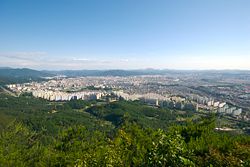 |
|||
|
|||
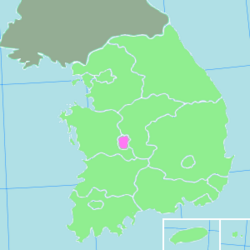 |
|||
| Country | |||
| Region | Hoseo | ||
| Districts | 5 | ||
| Government | |||
| - Mayor | Park Seoung-hyo | ||
| Area | |||
| - Total | 539.84 km² (208.4 sq mi) | ||
| Population (2007) | |||
| - Total | 1,442,857 | ||
| - Dialect | Chungcheong | ||
| Flower | White magnolia | ||
| Tree | Pine | ||
| Bird | Korean magpie | ||
| Website: metro.daejeon.kr (English) | |||
Daejeon (listen) is the capital city of Chungcheongnamdo Province, located in the center of South Korea. It is the fifth largest city in South Korea, with a population of 1,442,856 at the end of 2005.[1] It is at the crossroads of Gyeongbu railway, Honam railway, Gyeongbu highway, and Honam highway. Within the city limits lies Daedeok Science Town, an area with more than 200 research institutions.
Contents |
History

The Daejeon area was historically known as Hanbat (한밭), a native Korean term for "large field", during the Joseon Dynasty. The term "Daejeon" simply means the same thing in Hanja.
Historically, Daejeon was a small village without many residents. However, in 1905, the Gyeongbu railway began operations from Seoul to Busan, opening a station at Daejeon. Soon after, in 1926, under rule of the Japanese government, the Honam railway was built between Daejeon and Mokpo, transforming the latter into a major transportation hub. Because of its geographical location and proximity to means of transportation, Daejeon grew quickly.
In 1932, the capital of Chungnam province was moved from Gongju to Daejeon. After numerous changes were made to the city boundaries, among them one that effectively made the nearby town of Daedeok a part of the city in 1983, Daejeon was designated in 1995 as a metropolitan city.
In 1997, the Daejeon Government Complex was constructed as part of an effort to move move some government offices away from the densely populated capital, Seoul.[2] The population of Daejeon increased dramatically as a result.[3]
Today, Daejeon's population growth is the second highest in the country, after Seoul, resulting in a large number of new apartment complex projects and high-tech industries in Yuseong-gu.
Geography

Daejeon lies between latitudes N36°10'50" to N36°29'47" and longitudes E127°14'54" to E127°33'21" near the middle of South Korea. It is 167.3 km from Seoul, 294 km from Busan and 169 km from Gwangju. Sejong City, which is planned to be the new administrative capital of South Korea, will also be close by. The city is surrounded by several mountains, and Gyeryongsan National Park straddles the city border to the west. Three streams which eventually join with Geum River, called Gapcheon (갑천), Yudeungcheon (유등천), and Daejeoncheon (대전천), flow through the city from south to north.

Administrative divisions
Daejeon is divided into 5 wards ("Gu"):
Central business district

Daejeon has become the recipient of the country's effort to decentralize certain ministries of the national government. The middle of the city or the new central business district called Dunsan is where the effort has manifested itself. Newer apartment complexes, albeit structurally similar to that of the rest of the city, sprung up around the new government structures being constructed concurrently in just a few short years starting from the mid-1990s. Newer municipal buildings including the city's courts and the province's main parliamentary building soon followed. The result is a several square mile neighbourhood full of restaurants, standard Korean western-type bars and coffee shops. The area is a place for the workers of the new Daejeon to live close to their offices, most able to walk to work, and dine and shop in a new urban environment.
Education

Being known as the Silicon Valley of Korea, Daejeon is home of various private and public Research Institutes, Centers and Science parks (i.e. R&D centers of Samsung, LG, Korea University of Science and Technology & others are located within Daedeok Science Town in Yuseong-gu.
The Korea Advanced Institute of Science and Technology is an institution of higher education focused on research in science and technology, and was ranked as the best Asian science and technology school by Asiaweek in 2000.[4] It is also home to the Information and Communications University, which specializes in research in information technology, and Daejeon Science High School, which is a selective high school focused on teaching science.[5]
Chungnam National University, a major national university established for the South Chungcheong province, and Pai Chai University, which is one of the oldest private universities in South Korea, are also located within the city.
Research and Development
Daejeon features twenty-three research institutes. Best known among them are the Korea Research Institute of Bioscience and Biotechnology (KRIBB), the Korea Atomic Energy Research Institute (KAERI), a leader in nuclear power, the Electronic and Telecommunications Research Institute (ETRI) whose WiBro technology has been adopted as the international standard for 3G wireless communication, the Korea Aerospace Research Institute (KARI), developer of the KOMPSTAT satellite program and the National Fusion Research Institute which just unveiled the KSTAR nuclear fusion reactor.
Culture
Parks

In 1993, an international exposition (Expo '93) was held at Daejeon. Several landmarks such as the Hanbat Tower and the Expo Bridge were built at this time. After the exposition ended, the grounds were refurbished as Expo Science Park. Next to the park is the National Science Museum, which had moved to its current location in 1990.[6]
There are not too many sight seeing locations in Daejeon. Most of the cultural centres and sight seeing places are located in Yuseong-gu district with the exception of Ppun park and Daejeon Zoo.
Arts
The Daejeon Museum of Art, located in Dunsan Grand Park, is an art museum focused on the convergence of art and technology. Since it was established in 1998, numerous exhibitions on contemporary art have been held. Another important cultural institution is the Daejeon Philharmonic Orchestra, which performs in Daejeon's new Arts Center and other local venues, and which recently completed several international tours, including visits to the United States and Japan.
Sports
The Daejeon World Cup Stadium was constructed in preparation for the 2002 FIFA World Cup. Several games have been held there, including the South Korea vs. Italy match in the second round. It is also the current home for the K-League football club Daejeon Citizen, and National League side Daejeon Hydro & Nuclear Power FC. Daejeon also hosts amateur football club Daejeon de la Cuba, which plays in the Super Sunday Football League.
The city is home to LPGA golfers Se Ri Pak and Jang Jeong, as well as the South Korean actor Kwon Sang-woo. Daejeon is also the hometown of former New York Mets left-handed reliever Dae-Sung Koo.
Media
Daejeon is a provincial center for the television, newspaper and publishing industries.
In Daejeon, major television broadcasting companies such as KBS, MBC have branches. TJB is a local television broadcaster based in Daejeon. In most apartments, cable TV services are available. 8 channels of Mobile TV are provided with the digital radio channels. Several FM radio stations provide news and music on the air. KBS, MBC, TJB has their FM radio channels and there are Christian radio channels, FEBC and CBS, and traffic news channel TBN.
Daejeon ilbo is a local newspaper which covers South Chungcheong province.
Transportation

Daejeon is a center of transportation in South Korea, where two major expressways, Gyeongbu highway and Honam highway, and two major railways, Gyeongbu railway and Honam railway, are joined. Travel time between Daejeon and Seoul using the high-speed railway system, otherwise known as KTX, is about fifty minutes. The nearest airport to Daejeon is Cheongju Airport, about a thirty-minute drive north of Daejeon.
Subway
One line, Daejeon Subway Line 1, of a planned five line subway system has been operating since April 17, 2007 (partial operations on this line began on March 16, 2006). This subway line connects Daejeon station, located in the original city center, with the more modern and more recently developed sections of this city, including Dunsan, where the city hall and a number of national government buildings are located.
Notable differences between the Daejeon subway and the Seoul subway include narrower cars, no doors connecting cars, four cars per train rather than ten, and storage space space under the seats for use by passengers.[7] The subway also uses round plastic tokens instead of the flat, magnetic paper tickets used in Seoul. The tokens are read by a proximity sensor when when entering the turnstiles, and then inserted into a slot when exiting. The design of the of the tokens allows them to be used for advertising.[8] Platform screen doors are installed in the subway stations.
Sister cities
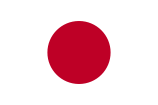 Oda, Japan — 1987
Oda, Japan — 1987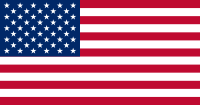 Seattle, United States — 1989
Seattle, United States — 1989 Budapest, Hungary — 1994
Budapest, Hungary — 1994 Nanjing, China — 1994
Nanjing, China — 1994 Calgary, Canada — 1996
Calgary, Canada — 1996 Guadalajara, Mexico — 1997
Guadalajara, Mexico — 1997 Uppsala, Sweden — 1999
Uppsala, Sweden — 1999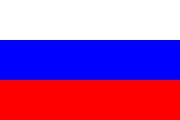 Novosibirsk, Russia — 2001
Novosibirsk, Russia — 2001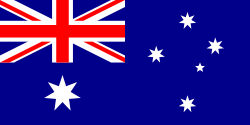 Brisbane, Australia — 2002
Brisbane, Australia — 2002 Binh Duong, Vietnam — 2005
Binh Duong, Vietnam — 2005 Wuxi, China — 2006
Wuxi, China — 2006
See also
- List of cities in South Korea
- List of Korea-related topics
References
- ↑ "Population, Households and Housing Units". Korean Statistical Information System. Korea National Statistical Office. Retrieved on 2007-02-28.
- ↑ "Daejeon Government Complex". Government Buildings Management Service. Retrieved on 2007-02-22.
- ↑ Oh, Changyeop (2006-03-22). "Daejeon, Larger Population than Gwangju" (in Korean), Prometheus. Retrieved on 2007-02-22. "이러한 대전의 인구증가 요인은 지난 1998년 정부 대전청사 이전과 철도시설공단, 행정중심복합도시 건설청 등이 자리를 잡은 것과 관련이 있다."
- ↑ "Asia's Best Universities 2000", Asiaweek (2000-06-30). Retrieved on 2007-02-21.
- ↑ "Daejeon Science High School" (in Korean). Retrieved on 2007-02-21. High schools in South Korea usually do not require special entrance exams.
- ↑ "History". National Science Museum of Korea. Retrieved on 2007-02-28.
- ↑ "Riding Daejeon Subway" (in Korean). iris's talk on above 18 & computers & and society (2006-05-08). Retrieved on 2007-02-28.
- ↑ "Visiting Daejeon Subway" (in Korean). Korean Faction (2006-03-17). Retrieved on 2007-02-28. "뒷면에는 대전소재 배재대학교의 광고가 새겨져있었습니다."
External links
- Daejeon Metropolitan Government
- Daejeon Tour
- Yuseong-gu District Website
- Seo-gu District Website
- Daedeok-gu District Website
- Dong-gu District Website
- Daejeon travel guide from Wikitravel
- Daejeon at the Open Directory Project
- Daejeon is at coordinates
|
|||||
|
|||||||||||||||||